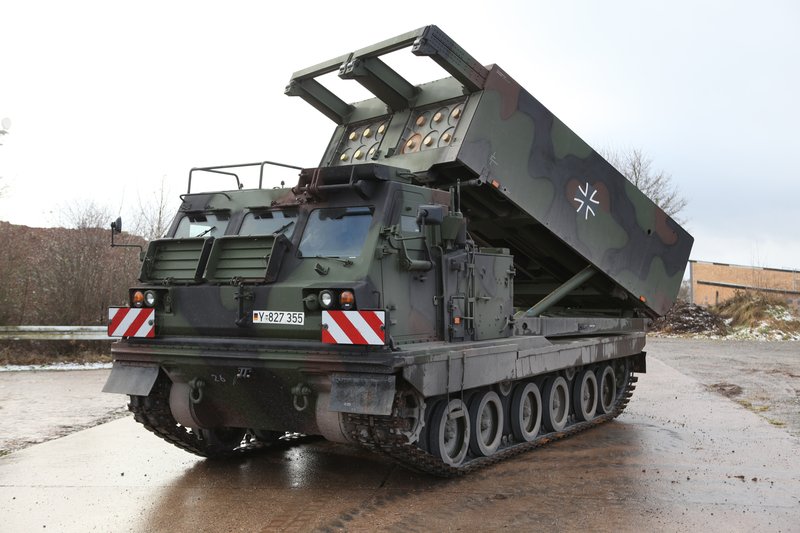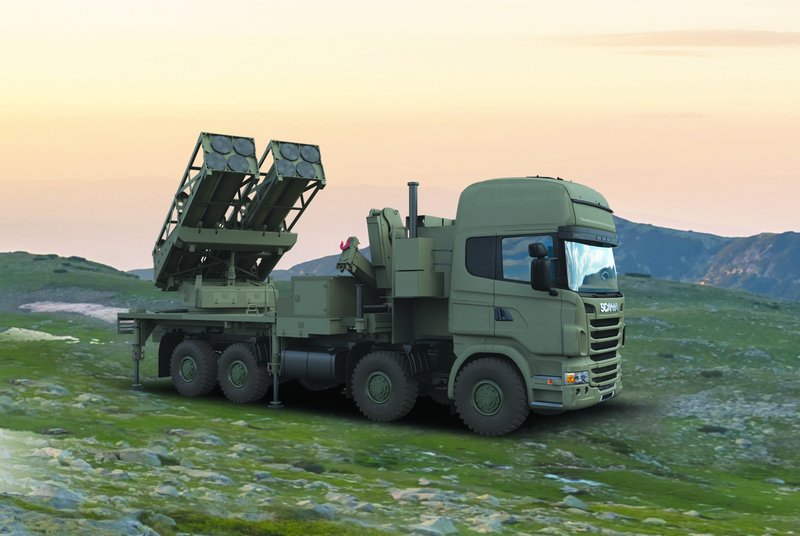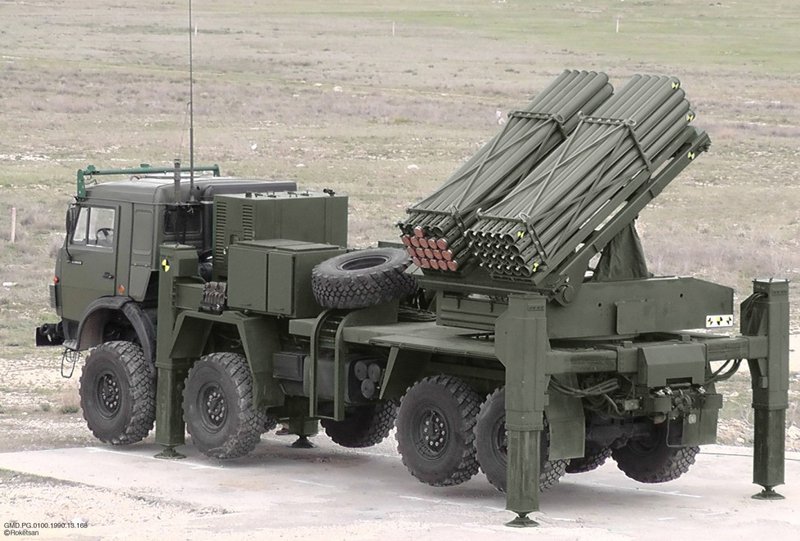Divergent paths – how NATO members are abandoning standardisation for artillery rockets
For many years the key artillery rocket capability fielded across NATO was the Lockheed Martin M270 Multiple Launch Rocket System but now many member states are going their own way.
The 227mm 12-round M270 MLRS tracked launcher was produced under licence by a European consortium for France, Germany, Italy and the UK... Continues below
Newsletter Sponsors:

Above: German M270 MLRS are known as MARS II and this example’s launcher is elevated and traversed slightly to the right. The system originally fired M31 unguided rockets to a maximum range of 31.6km. (Photo: KMW)
These countries also manufactured the original Phase 1 unguided rocket which contained 644 sub-munitions and had a maximum range of 31.6km. Germany and the UK also took delivery of rockets carrying 28 AT2 antitank mines.
In addition to two pods each of six 227mm rockets, the M270 can also support a pair of pods containing one Army Tactical Missile System (ATACMS), but this is not currently deployed by any of these four countries, although strong interest has been expressed in the past.
Two further NATO countries, the Netherlands and Norway, purchased M270 systems and associated rockets direct from the US, rather than via the European consortium.

Explore armored vehicles and turret systems of Otokar, the global land systems manufacturer.
Both subsequently phased out their M270s as they used Phase I rockets containing sub-munitions now banned under the Ottawa Treaty on land mines.
The original four operators upgraded their launchers with a new fire control system (FCS) as well as purchasing Guided MLRS (G-MLRS) rockets from the US. This has a range extended to 70km, dependent on ambient conditions. The UK went for the existing US FCS while the other three opted for a European solution.
Germany calls its upgraded variant the MARS II and some have been provided to Ukraine. The UK has also donated upgraded M270B2 launchers to Kyiv, as has the US.
The M270, usually upgraded, is still used by Bahrain, Egypt, Finland (ex-Netherlands stocks), Greece, Israel, Japan, South Korea and Turkey.
According to Lockheed Martin well over 60,000 G-MLRS rounds had been built by late 2023 with current production models having a blast warhead.
Under contract to the US Army, the company has been developing a longer-range rocket with the first test flight taking place last May. Its warhead meets current regulations and is also insensitive munition (IM) compliant.

This Precision Strike Missile (PrSM) Increment 1 is now in low-rate initial production under an Urgent Material Release contract signed in Q4 2021.
First deliveries were made on 8 December last year following production qualification testing at White Sands Missile Range in November.
Intended as a replacement for ATACMS, PrSM can be launched from the M270A2 and M142 High Mobility Artillery Rocket System (HIMARS).
It will be followed by Increment 4, for which development contracts were awarded in March 2023 to Lockheed Martin and a consortium of Raytheon and Northrop Grumman. This will have a range of over 1,000km.

Above: A rendering of the latest Precision Strike Missile Increment 1 (previously known as Extended Range MLRS) as it would appear in flight. (Image: Lockheed Martin)
In the UK meanwhile MBDA is looking at the Land Precision Strike (LPS) missile for the British Army’s M270s, while Thales UK and Lockheed Martin UK are working on new payloads (a terminally guided sub-munition and an ISTAR capability respectively), with both funded by the MoD. While the UK and US will have launcher commonality, there is now a parting of the ways on munitions.
As with all artillery, a key aspect is target acquisition. In the past rockets have mainly been an area effect weapon, or as one observer mentioned in the Gulf wars, a ‘grid removal system’.
Today the end user not only requires more range but also greater effect on the target. Most latest-generation rockets have a guidance system to reduce circular error of probability (CEP) to 10m or less.
Not only does this mean that fewer rockets are required to neutralise a target, but also the logistic footprint is much reduced.
Some members of NATO have now purchased completely different rocket artillery systems, with Poland going for the Hanwha Chunmoo, which was originally developed to meet the requirements of the Republic of Korea Army and has been exported to Saudi Arabia and the UAE.
Other articles in this newsletter:
Shoulder-launched anti-armour weapons take to the skies with UAS integration
How Sweden is evolving the CV90 IFV and supporting Ukraine
It is based on an 8x8 platform designated K239 with a protected forward control cab. The original version had two pods of six CGR-080 missiles but rockets with extended range have been developed and the complete family now consists of three types of round, all of which have a solid propellant motor. The longest-range CTM-290 is effective out to 290km but only two can be carried by the launch vehicle.
For many years the Spanish Army deployed the locally designed and built Teruel 140mm 40-round unguided rocket launcher which was based on a 6x6 platform, having a maximum range of 28km.
These have now been phased out and it is expected that Madrid will acquire a new system which could be HIMARS, Elbit’s PULS or a Brazilian Avibras launcher.
The Netherlands Army has opted for the Israeli PULS rather than HIMARS and in May 2023 placed a contract worth $305 million for 20 truck-mounted systems plus ammunition, training and support equipment to be delivered over a five-year period. Denmark has also ordered two PULS batteries under a $133 million contract.
PULS is a complete family of rockets, most of which are guided and enable a considerable target overlap.
The basic Accular is a 122mm round with a range of 35km and is marketed in guided (RGK 122) and unguided versions. A nose-mounted guidance package can be retrofitted to existing rockets.
An Accular 122mm pod contains 18 rockets and two can be carried on a launcher, while the 160mm pod has ten rockets with a maximum range of 40km.

Above: Elbit’s PULS launcher seen here integrated onto a Scania chassis with stabilisers lowered and two pods each containing four guided rockets. (Photo: Elbit)
For engaging targets at longer ranges there is the Extra (four rockets per pod) with a range of up to 150km and Predator Hawk (two per pod) effective up to 300km. All have a claimed CEP of 10m.
For special forces missions there is the Light PULS which is typically based on a 4x4 tactical platform with a pod of eight 122mm Acculars.
Krauss-Maffei Wegmann (KMW) has teamed with Elbit to offer PULS to the German Army as a follow-on to the M270 MARS, but it could also be supplied mounted on a wheeled platform.
KMW is proposing a number of launch vehicles including the IDV GTF 8x8 which could not only support pods of Elbit rockets but also G-MLRS, Kongsberg’s Naval Strike Missile or the MBDA Deutschland Joint Fire Support Missile.
Meanwhile Lockheed Martin has teamed with Rheinmetall to offer a European-made launcher based on the M142 HIMARS but using an RMMV HX 8x8 platform which could carry two pods of 227mm rockets rather than one.
The US Army has long supplemented its tracked M270 with the six-round 227mm M142 based on an FMTV 5t 6x6 truck with a protected forward control cab.
Although the one-pod HIMARS has less firepower than the M270, as it is wheeled it has greater strategic mobility and can be transported by aircraft such as the C-130 Hercules.
HIMARS is also in service or on order with an increasing number of countries, including Australia, Estonia, Jordan, Lithuania, Morocco, Poland (first delivery May 2023), Romania (the first European customer, for 54 units), Singapore, Taiwan, Ukraine and the UAE, all of which have purchased G-MLRS and associated training rockets.
In mid-December Latvia also signed a contract with the US for a batch of M142s and associated missiles valued at $164 million with deliveries from 2026-2027.
Then on 15 December, the US Defense Security Cooperation Agency announced the possible sale of 21 HIMARS plus support equipment to Italy, with a total value of $400 million.
The same month, a Lockheed Martin spokesperson stated (perhaps unsurprisingly) that ‘HIMARS is ramping up production from 60 to 96 annually’.
As is often the case, NATO member Turkey offers its own solutions and Ankara-based Roketsan is the largest manufacture of artillery rockets in Europe, having landed some major export orders, especially in the Middle East.
It started off with 107mm unguided weapons but has since expanded its portfolio to create the largest family of artillery rockets outside China and Russia.
The shortest-range system is the unguided 122mm TR-122 which has a maximum range of 36km. These are mounted in pods of 20 with a typical 6x6 or 8x8 launcher having two pods.

Above: Roketsan’s TR-122 rocket system deployed in firing position with launcher traversed right and stabilisers lowered. (Photo: Roketsan)
There is also a guided version, TRG-122, with 12 rockets per pod, a maximum range of 30km and a claimed CEP of 20m. A laser-guided variant (TRLG-122) has a claimed CEP of just 2m.
Larger calibre options are the 230mm TRG-230 with a range of 20-70km and CEP of 10m and the laser-guided TRLG-230 with a similar range and CEP of 2m again.
The TRG-300 is a four-barrel guided rocket system with the Block II having a maximum range of 90km and Block III reaching 120km.
Lasly there is the Khan which is a 610mm missile with a range of between 80 and 280km with a claimed CEP of 10m fired from a two-round 8x8 launcher.
Roketsan also offers resupply, C2 and meteorological vehicles plus associated maintenance assets to deliver a complete system.
These have yet to find favour with European NATO members, but their export success elsewhere indicates they are a serious alternative.
While this diversity across NATO provides options for different mission sets (and budgets), the fact that there are an increasing number of different artillery rocket systems in the alliance, often with a long supply line, makes interoperability that much more difficult, which will pose challenges if a sustained coalition operation is called for.
Don't want to miss out on future Decisive Edge content? Make sure you are signed up to our email newsletters.












